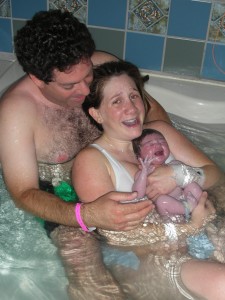 By Naomi Aldort, author of Raising Our Children, Raising Ourselves, www.naomialdort.com
By Naomi Aldort, author of Raising Our Children, Raising Ourselves, www.naomialdort.com
Q: I have read about raising babies without diapers, or getting them out of diapers by two. I am pregnant and would like to do that with my second baby. However, I did not do that with my first child, and now my daughter is three-and-a-half and still in diapers. How can I help her to toilet-train, and how do I start it better with my second baby?
A: Human beings of all ages must be the sole owners of their bodies. Like you, your toddler wants to make her own bodily choices and timing. It is very crucial never to “train” or entice a child to get out of diapers. It is her body. You don’t want to teach her that someone else can decide things about her body.
Any attempt to toilet-train can slow the child down. In addition, many children develop inhibition and emotional discomfort with their own bodies due to pressure to get out of diapers. If you have used disposable diapers, it will take the child longer to change a familiar habit that has little consequence for her.
I suggest that you change to cotton diapers and drop the subject completely. In cloth diapers, your daughter will fully feel her own eliminations. Without pressure, she will eventaully want to stay dry and she will use the toilet of her own initiative. Being autonomous, she will be emotionally healthier and self-reliant.
Infants are aware when they eliminate and can indeed grow without diapers or with a minimal need for them. In natural societies, a baby is often carried naked on her mother’s body and when she needs to eliminate, the mother knows it and holds the baby away from her body above ground or a container. In his book, Magical Child, Joseph Chealton Pearce tells of a doctor who visited a natural tribe and was perplexed by mothers’ ability to know when the baby has to eliminate. “How do you know when your baby needs to go?” this doctor asked a mother whose naked baby was snuggled against her bare body. She looked puzzled and said, “How do you know when you need to go?”
The first lesson most babies receive in Western civilization is that elimination occurs in the privacy of their own clothes and is then ignored some of the time. They learn to become unaware of their bodily functions because we don’t respond promptly. The child is so comfortable with these familiar sensations that giving them up may not be so easy. You are asking her to change what she assumed was part of life and of herself and is very convenient.
Babies Know Their Bodies
With your next baby, try using elimination communication and/or cloth diapers with communication. The following are guidelines on how to nurture natural elimination awareness, followed by ways to recognize babies’ elimination cues.
Nurturing the baby’s awareness of her own body functions:
• When your baby is eliminating, acknowledge what is going on with a sound or words — With delight and ease, let him know what he is doing and change his diaper as soon as he is done (or take him to the sink or toilet to eliminate without a diaper.) An aware baby wants to be dry because that’s what he is used to.
• For faster growth out of diapers, use cotton ones — With cloth diapers, the baby is instantly aware of his own experience. Your prompt removal of the diaper brings that awareness to a sharp focus. All-in-one cloth diapers are as or more convenient than disposable and they are better for your baby’s skin, her health, and the environment. Clear the soiled ones into the toilet and put all the dirty diapers in a pail with water and vinegar till you launder them.
• Have your baby and toddler watch you on the toilet — Acknowledge what you are doing with the same sounds as you make when she eliminates.
• As soon as your baby crawls or walks, put a potty next to the toilet — Just have it available without an agenda. Your wee one wants to be like you. With autonomy and self-awareness, she will take the initiative when ready and will become more independent by learning to rely on herself.
While I am diving into the details of moving from diaper to toilet, I would like to suggest that, as parents, we have the opportunity to bring to an end the habit of males who pee standing and leave a mist of urine all around. I have raised three boys who sit while they pee and so does their father. It seems much more civilized and makes the bathroom a nicer place for all.
Here are some typical cues babies and toddlers give when they are about to eliminate:
• Timing — Many babies go at specific intervals and times. Notice if the baby eliminates at a set number of minutes after nursing, specific times of the day or fixed intervals.
• Facial expressions — Babies give us cues like tensed face, raised eyebrows, frowning, concentrating, pausing as though listening, becoming motionless, squirming, fussing, making specific sounds and/or movements, sudden increase or decrease of activity, stirring or waking from sleep, looking intently or reaching for you.
• Movement — For an older baby, signals could also include moving toward the bathroom, holding the genitals, grunting, struggling to get out of a car seat or a snugly, or trying to get off padded places.
• Intuition — You may find that you develop intuitive recognition of your baby’s physical need to eliminate even before they occur. Your mind may actually tell you that your baby needs to go. Listen to it. If you need to pee, it is possible that your baby needs to as well. One mother told me that she gets the sensation of warm wetness on her lap while the baby is still dry and the baby pees shortly after.
• When using diapers — When you know that the baby is going to eliminate, say, “You are going to pee now” and as soon as she does, add the sounds of whatever the event is and promptly change her diaper. After she has cleared her bowel, let her walk around naked as much as possible. If she ends up peeing when nude, give her the same verbal feedback; she sees, feels, and hears you and her awareness will grow.
• Using the sink or toilet — With your baby, you may be able to get to the bathroom before the diaper is soiled. However most babies, once they start to crawl or walk, are too busy to bother with the bathroom and you may have to use cotton diapers. Respect the baby’s or toddler’s choice, but if she is inclined to try the potty, let her. Respond to the child’s preference not as the director, but as the nurturer of her path. If the child senses that you want her to go in the potty, she may resist doing so and stay in diapers for a longer time; it must be her own desire.
• No cheerleading — Stay neutral in your attitude. If your child senses that you are invested in her choices, she will either back off and delay getting out of diapers, or become dependent on pleasing and seeking approval. Children who are in diapers for longer are often waiting for parents to get out of the way so they can be in charge of themselves.
Have you noticed that when you are with your adult friends, you cannot tell when each one of them got out of diapers? If you already used manipulation and your child is resisting the toilet, make peace with reality and stop showing any interest. Enjoy every minute of surrender and delight. Early toilet training does not mean anything, and it often makes life with wee ones more difficult as you have to stop the car, interrupt dinner, and take junior to handle his business.
If you do elimination communication from early on, your child maybe a reliable user of the toilet. Or, she may pee on the floor sometimes. Living mostly indoors, I find that providing a child with cottom diapers is more respectful of her than having her pee on the rag. Trust your child’s inner guidance. It is reliable. Everything unfolds right on time as long as we understand the cues and respond to them.
Q: My daughter calls her brother stupid and he feels hurt. He does the same in return. I tried everything, but neither of them will stop. How do I teach them to stop hurting each other and to use proper language?






